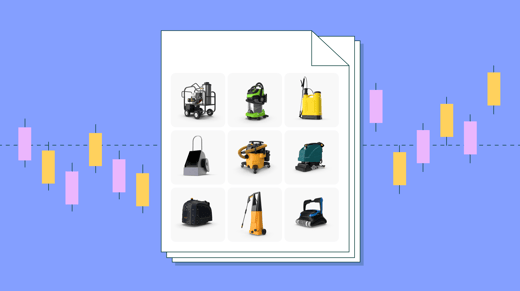
What is Catalog Management?
Catalog management is the process of organizing and managing a catalog of products or services. A vital part of e-commerce businesses, catalog management can include creating and maintaining product descriptions, setting prices, and managing inventory levels.
Catalog management tools allow you to manage, store, retrieve, perform, and optimize the omnichannel maintenance of your e-commerce catalogs while structuring them according to a range of factors such as:
- Product names
- Descriptions
- Prices
- Suppliers
- Hierarchy
- SKUs
- Other product details.
An effective catalog management system can help businesses boost sales and improve the customer experience by:
- Keeping track of their products or services
- Ensuring that pricing is up-to-date and accurate
- Streamlining the ordering process
In this article, you'll learn the importance of e-commerce catalog management, the various types of product catalog management, and the benefits of using a product information management system for catalog management.
The Importance of E-Commerce Catalog Management
E-commerce catalog management is essential for several reasons. It is an important tool that can help businesses increase sales and manage their inventory more effectively while creating a more efficient and enjoyable shopping experience for their customers.
Controls product information
Catalog management gives you total control over product information and ensures that it flows through the entire chain of a retail or e-commerce business. Catalog management is vital for e-commerce businesses with large volumes of inventory and hundreds of thousands of references.
Catalog management also allows your customers to find consistent information throughout your catalogs. When collecting and managing product information in an automated and centralized way, errors decrease. This is a stark contrast to the old days when a team of people manually collected and created catalog information offline or using Excel spreadsheets.
Standardizes multiple systems
With e-commerce businesses typically dealing with multiple suppliers and distributors, each with a different format, language and information system, a CM guarantees that the catalogs arrive standardized through all your sales channels.
Catalog management also distributes through various parts of the supply chain, channels, and marketplaces like Amazon, usually with their bespoke requirements.
Organizes product data across devices and networks
Catalog management applies to distributed databases, where information is kept across multiple devices or an extensive interconnected network. CM integrations with other systems free you from errors when transferring content from one computer to another.
In addition, an online Catalog Management software tool allows you to create electronic catalogs (e-catalogs). For instance, an online catalog can show product options, allows interaction, and supports online purchase and payment—a crucial element any e-commerce platform should have.
Presents your offerings more effectively
Catalog management allows businesses to showcase their products and services online more effectively.
By having a well-managed catalog, e-commerce businesses can implement effective product content management, ensuring that potential customers have a seamless user experience on the site. Potential buyers can easily find and learn about your products and services—helping to increase sales and conversion rates.
Manages inventory levels
E-commerce catalog management can help businesses with inventory management, keeping track of what products are selling well and which ones need to be restocked.
Streamlines your customers’ shopping experience for your customers
E-commerce catalog management can help businesses create a more efficient and streamlined shopping experience for their customers by quickly finding the products they are looking for and checking out quickly and easily.
Product Catalog Management Software Types
There are different types of catalog management tools available on the market today:
- Cloud-based offers the benefits of flexibility, scalability, and accessibility.
- On-premise is installed on a company's servers and offers more control over the software and data, though it may require more IT resources.
- Open-source is free to use and modify. It can be a good option for companies with the technical resources to customize the software to their specific needs.
- SaaS (Software as a Service) is a type of subscription-based software, which is typically lower cost and easier to use than on-premise software, albeit not having as much flexibility or control.
Cloud-based
A cloud-based catalog management software is one of the CMS options that has been increasing in popularity in recent years.
Its operation is based on the fact that work storage is not done in a single computer or network because it remains in the cloud. It is accessible from any device with an Internet connection, ideally with high-quality security and privacy system to rival anything you may have on-premise.
A cloud-based catalog system is a desirable option for modern companies who need to keep abreast of the latest technological possibilities while enjoying the flexibility required by global companies.
Our PIM or product information management is a B2C- and B2B-oriented product catalog management system. It assists you in the entire process of product information management, catalog creation, and display in every platform and channel that you can imagine with the speed of a cloud-based catalog system.
On-premise
On-premise software for catalog management plays an integral part in the market, although enterprises with large budgets and teams usually choose them.
An on-premise CMS involves installing the software catalog on the company's equipment and therefore requires more resources, IT infrastructure, implementation, and start-up time. It is a more expensive and slower alternative to cloud systems.
Oracle and SAP are the best-known and longest-running on-premise CM providers in this category. They offer the alternative of opting for an on-premise or cloud-based service.
Open Source
Open-source is an exciting option for young companies that want total control over their software catalog.
With this type of catalog management solution, the IT team will be able to modify the CMS code to their liking, installing the connectors they want and customizing it to the maximum.
While open source is much more affordable and scalable systems, they require a great deal of technical work that would require training to learn to use efficiently.
SaaS
With a SaaS (or Software as a Service) catalog system, it is possible to access the CMS remotely without long implementation periods.
As its name suggests, SaaS is not a program purchased and installed entirely on the company's computer (like on-premise) but remains on a server external to the company. The vendor then offers the cloud-based CMS hosting and maintenance to your company through a regular subscription (monthly, quarterly, or annually), and you can access the system remotely through an Internet connection.
Catalog Bar is an example of a SaaS catalog system. With an interface that is simple and easy to navigate, it allows you to add an unlimited number of products, media assets, and catalogs to the web and mobile versions of your e-commerce business.
Sales Layer is also a SaaS product information management software and has a long history working with B2B businesses.
Benefits of PIM as a Catalog Management Software
A product information management (PIM) system is a powerful tool that can serve as an excellent replacement for product catalog management software. Here are some reasons why:
If you're looking for a new solution for managing your product data, a PIM system is worth considering as an alternative to traditional tools for product catalog management.
Better pricing and ROI
PIM is lower in price than other product catalog management software helping you to get more for your money.
PIM facilitates this superior ROI by saving you time and costs as catalogs are created faster, launched sooner, and corrected earlier in the event of a change in product data. It brings your products to market quicker and maintains data quality—improving your bottom line and growing your business.
A PIM system can also scale more quickly than other software for ecommerce product catalog management, making it a good choice for growing businesses.
Get products to the market faster
In e-commerce and product sales, time to market is an essential concept that ensures timely growth is achieved.
Delays in launching new products, collections, or seasons not only push the timing of a company's objectives, but also slow down its profit-making opportunities. It can also harm your brand’s image if customer expectations are not met and product information is presented inconsistently.
Product information management (PIM) systems are critical for businesses to streamline their workflows and product catalog management. With PIM, time-consuming and manual methods are a thing of the past; you can ensure adherence to catalog creation and product launch deadlines and get products to market faster.
PIM enables product and e-commerce managers to create, update, and distribute product attributes in all platforms and channels (including marketplaces) quickly, efficiently, and error-free.
Worry less about managing data or organizing digital assets
A PIM system gives you a centralized database for all your product information, which means data management from a single platform rather than having to update multiple systems manually.
PIM can also work as a digital asset management system that can automate many of the tasks associated with catalog management, such as data entry and updates, making the process more efficient. It can provide greater flexibility in how your product listing is presented, making it easier to create custom catalogs.
Furthermore, a PIM system can offer better reporting and analytics capabilities, giving you more significant insights into your product data.
Choose Sales Layer PIM for Your Catalog Management Needs
If you're looking for a robust and comprehensive product catalog management system, then Sales Layer is the best solution for your needs.
Sales Layer’s PIM or product information management platform is one of the essential tools to achieve effective catalog management. It offers everything you need to get your products to the market faster while keeping your catalog updated and accurate.
With our easy-to-use interface, you’ll be able to centralize, automate and harmonize all your product information from all your sources and to any channel you want.
Manage your entire product catalog quickly and easily with Sales Layer. Try our free demo today.









